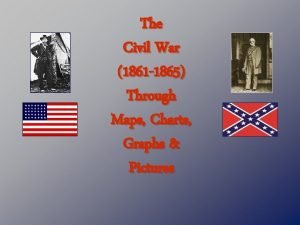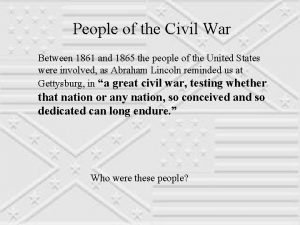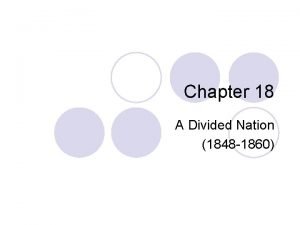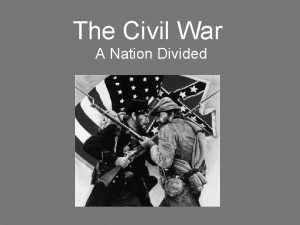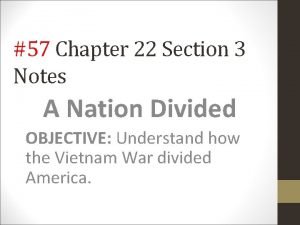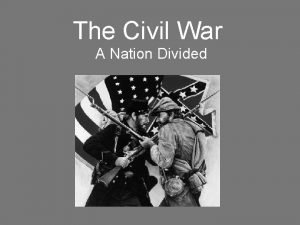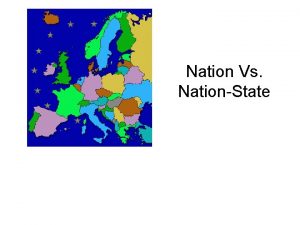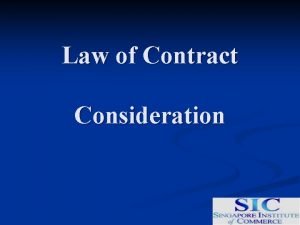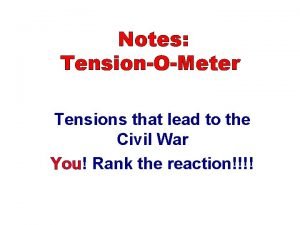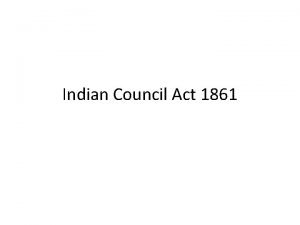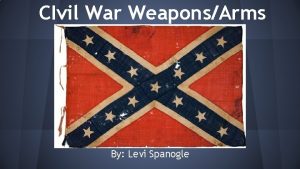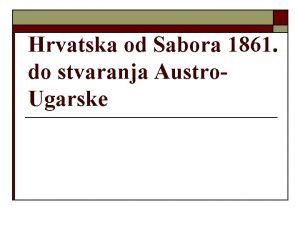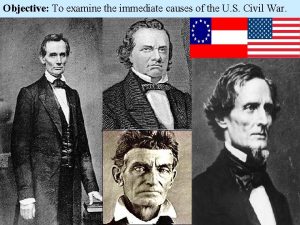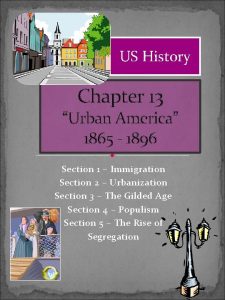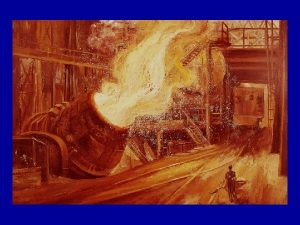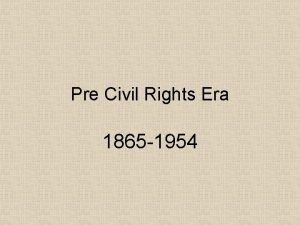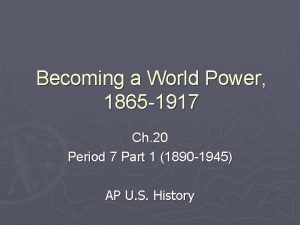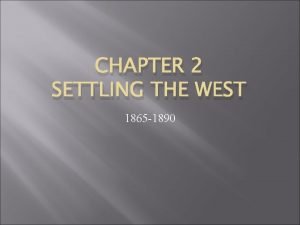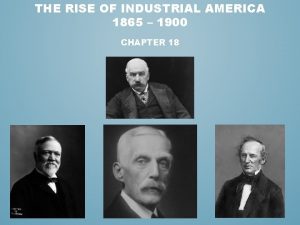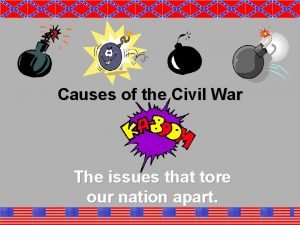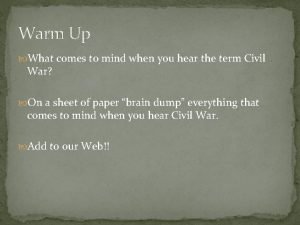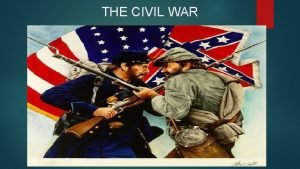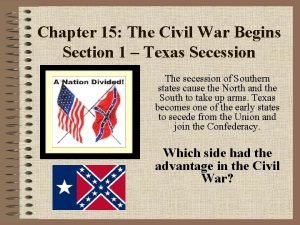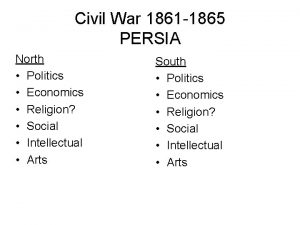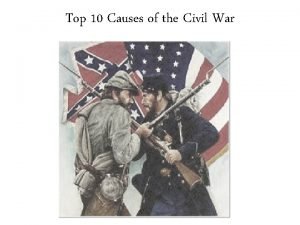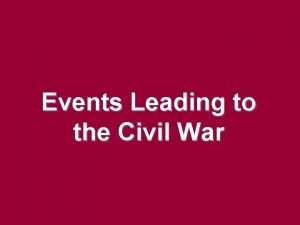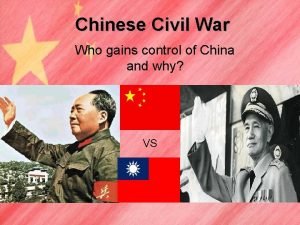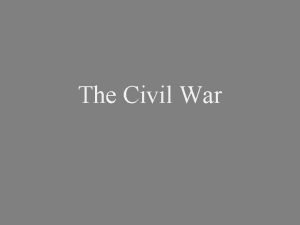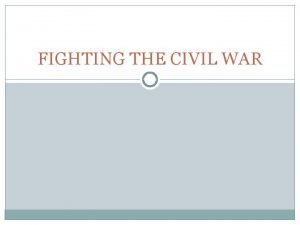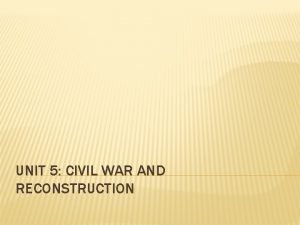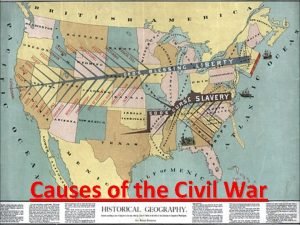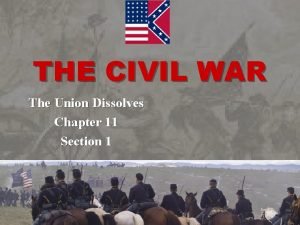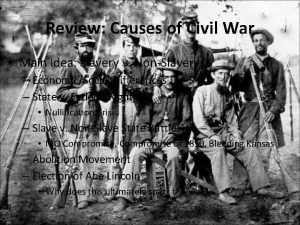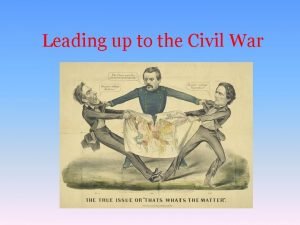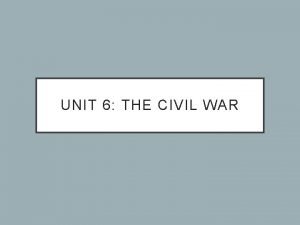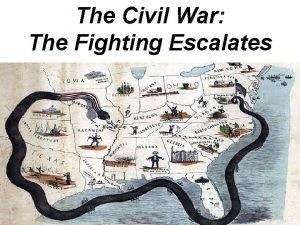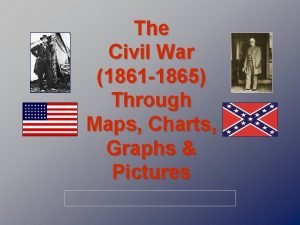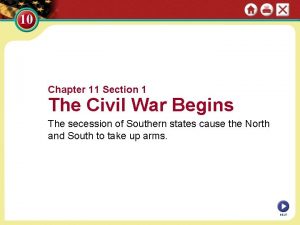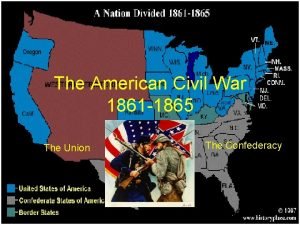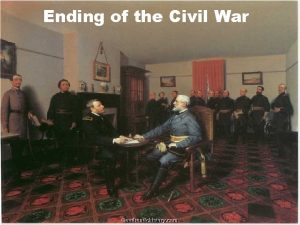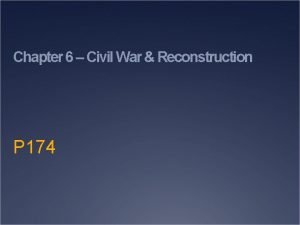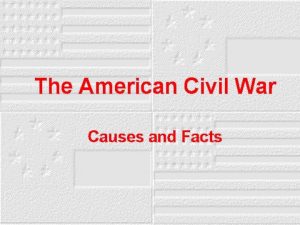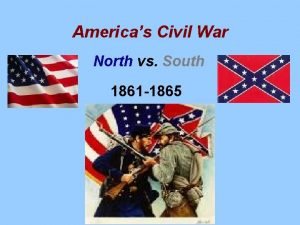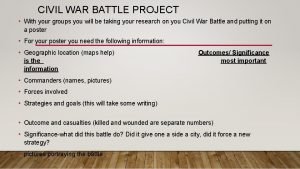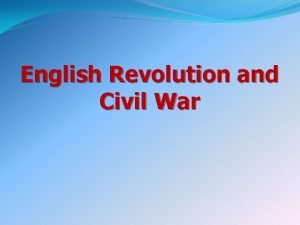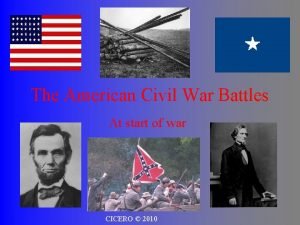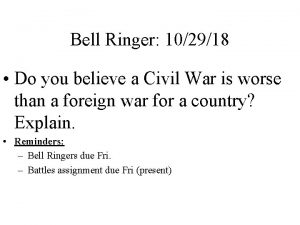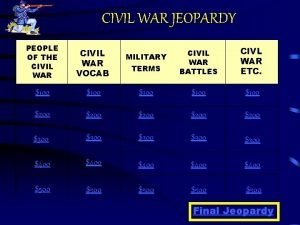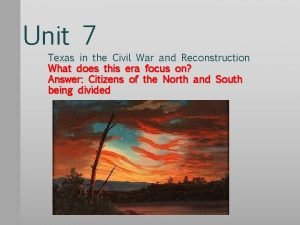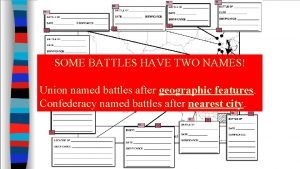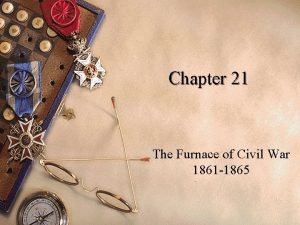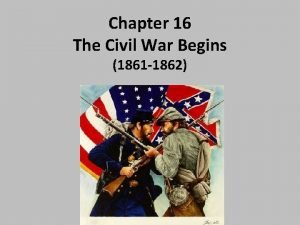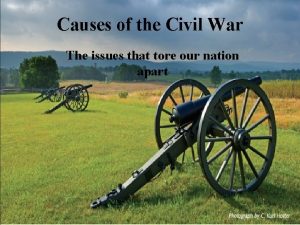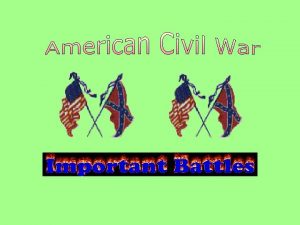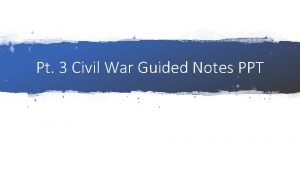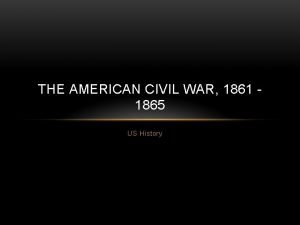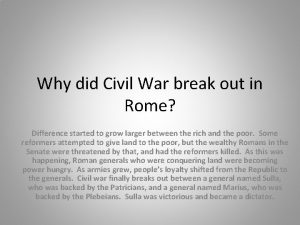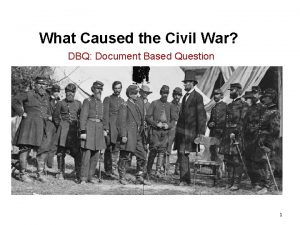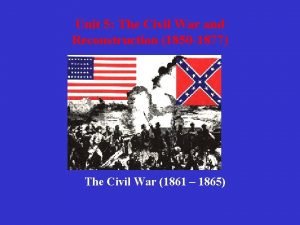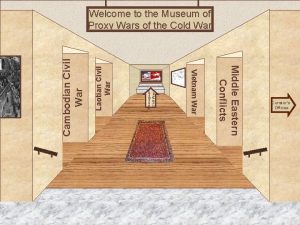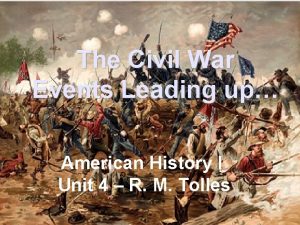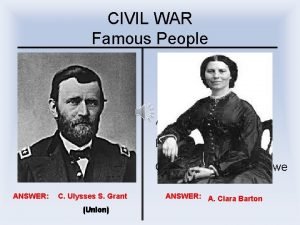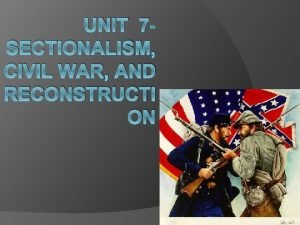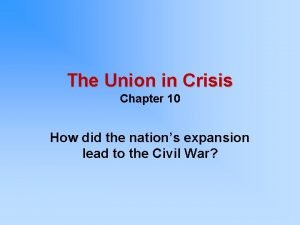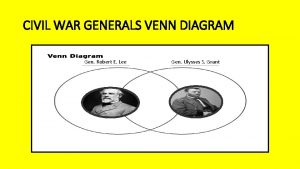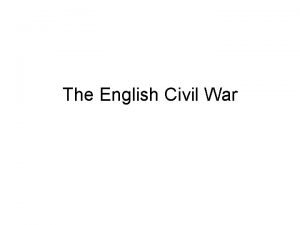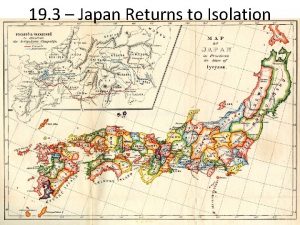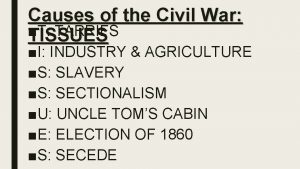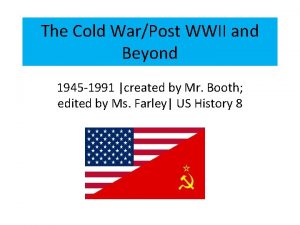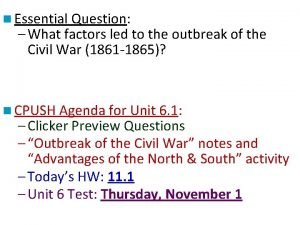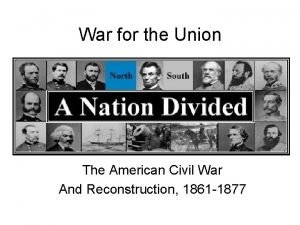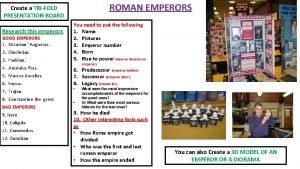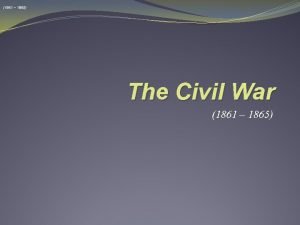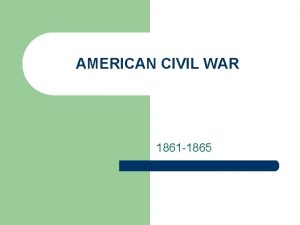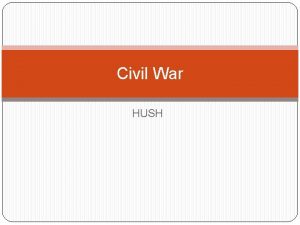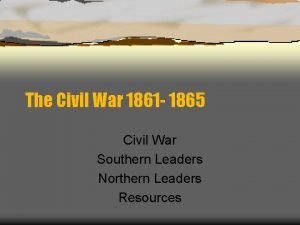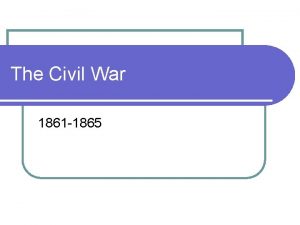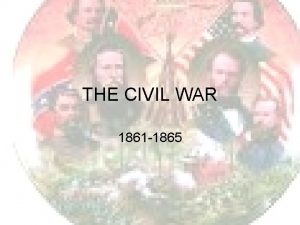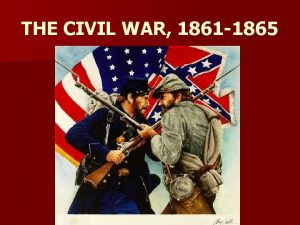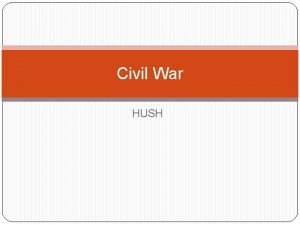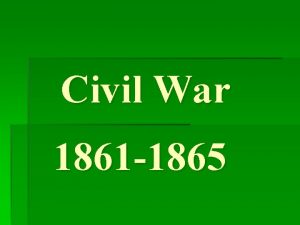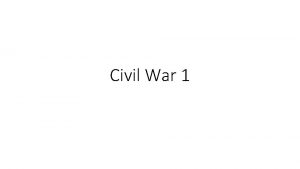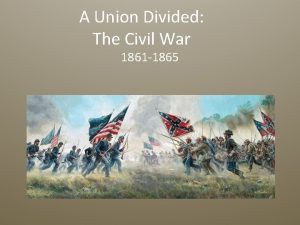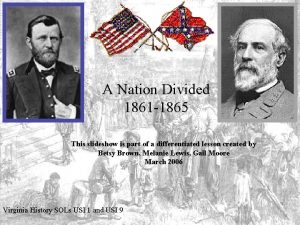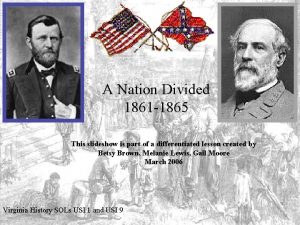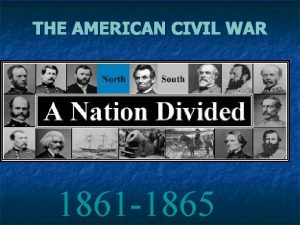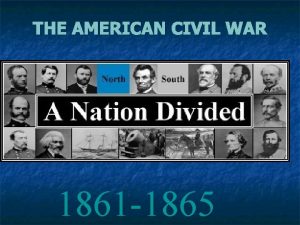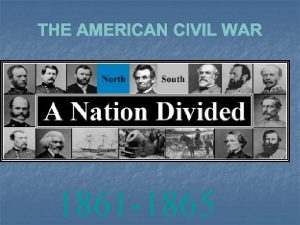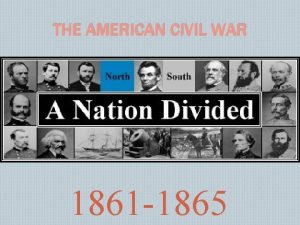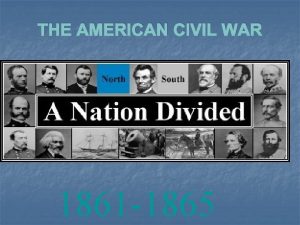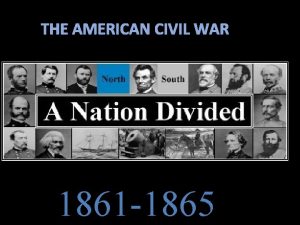A NATION DIVIDED THE CIVIL WAR 1861 1865



























































































































































- Slides: 155

A NATION DIVIDED THE CIVIL WAR 1861 -1865

Alabama and the Civil War Alabama would contribute military leaders, cabinet officials, troops, munitions and vital supplies to the Confederacy during the Civil War.

On what date did Alabama secede from the union? On January 11, 1861 Alabama would become the 4 th state to leave the Union, its secession convention calling for a meeting of delegates from all Southern states in what city? Montgomery- the capital of Alabama On February 4, 1861 the new provisional government of the Confederate States of America was organized, with Montgomery selected as its temporary seat and who was elected president of the CSA? Jefferson Davis

Alabama and the Civil War In one section of northern Alabama, where antislavery feeling was strong, there was a movement to form a pro-Union state. What was one of the counties in Alabama that did not succeeded from the union at the start of the Civil War? Winston County – Was known as the “Free State of Winston” Why were some northern Alabamians against secession? Northern Alabamians did not depend as much on cotton and thus held fewer slaves. Were not threatened by abolitions.

Other areas against secession East Tennessee n Rabun County in Georgia n Ozark Mountains in Arkansas n Jones County Mississippi n Western and Central North Carolina n Western counties of Virginia n

Turchin’s Raid of Athens (Athens) Limestone would be the first county in Alabama to be invaded by the North. In the spring of 1862, Union forces under a Russian-born Union officer named Ivan Turchinov (later named John B. Turchin) captured Athens, the wealthy county seat of Limestone County.

Turchin burned homes, robbed, and committed such chaos and damage that General Don Carlos Buell of the Union Army called Turchin’s raid of Athens a case of undisputed atrocity and Turchin was courtmartialed and sentenced to be dismissed from the army. Then for some unexplained reason, the case was dropped and he was promoted to brigadier general.

n At the beginning of hostilities Alabama state troops would seize forts at the entrance of Mobile Bay and the Union arsenal at Mount Vernon.

n n n There was no real fighting in the state early in the war but in 1862 invading Federal forces held sizable areas. To resist the invasion, almost every white Alabamian old enough to carry a gun enlisted in the Confederate Army. Some 2, 500 white men and 10, 000 blacks had already enlisted in the Union Army.

n n Alabama supplied, most of the iron used by the Confederacy, with an average annual output of 40, 000 tons during the 4 years of the war. The state would furnish the Confederate Army with some 60 -65 regiments of infantry, 12 -15 regiments of cavalry, and over 20 batteries of artillery.

The South moved the capital from Montgomery, Alabama to where? Richmond Virginia Why was the capital moved to Richmond? 1. Location might persuade states along the North-South border to secede. 2. Virginia had more developed industry than Alabama. 3. Richmond’s location near Washington, D. C. placed it closer to the sites of anticipated battles easing communication between Confederate generals in the field and their government.

Generals from Alabama LTG James Longstreet- most prominent general from Alabama. Lee’s Confederate General James most trusted lieutenant Longstreet in the Army of Northern 1821 - 1904 Virginia.

James Longstreet was born on January 8, 1821 in Edgefield District, South Carolina, the son Of planter James and Mary Ann (Dent) Longstreet. His father died when James was twelve. Although he was born in South Carolina, Longstreet considered Georgia his home.

n n “Fighting’ Joe” Wheeler Took part in more than 500 skirmishes and commanded in 127 battles. Almost constantly engaged in combat was wounded 3 times and had 16 horses shot from under him. Jefferson Davis praised him by saying “ one of the ablest, bravest and most skillful of cavalry commanders. ”

At the start of the war in 1861, Wheeler resigned from the U. S. Army to join the Confederate States Army. He was ordered to Huntsville, Alabama to take command of the newly formed 19 th Alabama Infantry Regiment, which he led into battle at Shiloh in April 1862. Wheeler later transferred to the cavalry and rose to the rank of Major General. Nicknamed "Fighting Joe", Wheeler was considered by General Robert E. Lee to be one of the two most outstanding Confederate cavalry leaders and saw action in many campaigns, including opposing William T. Sherman's advance on Atlanta.

Nathan Bedford Forrest (July 13, 1821 – October 29, 1877), was a Confederate general and perhaps the American Civil War's most highly regarded cavalry and partisan ranger (guerrilla leader).

n n Forrest is regarded by many military historians as the war's most innovative and successful general. His tactics of mobile warfare still studied by modern soldiers. After the war, Forrest's reputation suffered due to allegations of brutality in the Battle of Fort Pillow, as well as his role as the first Grand Wizard of the Ku Klux Klan.

Forrest Takes a Hostage On the last day of Shiloh, Nathan Bedford Forrest led his men in a reckless charge against Sherman. Outdistancing his men, he soon found himself surrounded by Yankee troops. So, he grabbed a small one to use as a shield while he shot himself out of trouble.

Other Generals n n n BG James H. Clanton MG Henry De. Lamar Clayton BG W. W. Allen BG W. F. Perry BG Danville Leadbetter BG James T. Holtzclaw BG George D. Johnston BG James Cantey BG Alpheus Baker BG Young M. Moody BG Archibald Gracie BG Z. C Deas

Other important Alabamians who helped the Confederacy

Josiah Gorgas (July 1, 1818 – May 15, 1883) was one of the few Northern-born Confederate generals in the American Civil War. As chief of ordnance, he managed to keep the Confederate armies supplied with weapons and ammunition, despite the Union blockade and even though the South had hardly any munitions industry before the war began. He kept diaries during the Civil War, which are now a popular subject of study for historians.

Emma Sansom

n Emma Sansom (June 2, 1847 – August 9, 1900) was an Alabama farm girl noted for her bravery during the American Civil War.

Raphael Semmes (September 27, 1809 – August 30, 1877) was an officer in the United States Navy from 1826 to 1860 and the Confederate States Navy from 1860 to 1865. During the American Civil War he was captain of the famous commerce raider CSS Alabama, taking a record fifty-five prizes. Late in the war he was promoted to Admiral and also served briefly as a Brigadier General in the Confederate States Army.

Monitor/Merrimack (Ironclads) These ironclad ships could splinter wooden ships and withstand cannon fire and resist burning. n General Grant used four ironclad ships when he captured Ft. Henry and Ft. Donelson. n On March the 9, 1862 the North’s Monitor and the South’s Merrimack fought a historical duel. n

n The engagement, known as the Battle of Hampton Roads, was part of a Confederate effort to break the Union blockade of Southern ports, including Norfolk and Richmond, Virginia, that had been imposed at the start of the war.

CAUSES OF THE CIVIL WAR Northern Aggression The causes of the war were complex. 1 st cause. Slavery- abolitionist in the North said that slavery was wrong and should be abolished. Today that is true. Thus led to the fight of slavery begin right or wrong and even as far as Biblical passages begin quoted. The establishment of colonies outside for the slaves.

2 nd cause- Sectionalism- This was a war between sections (North) the national government and the (South). All started when the Northern sections won control of the Congress and the presidency. The South felt threatened. Started also over the West as well when a new state came in either as a slave or free state.

3 rd cause- Came from the different economic interests of the North and the South. Owners of factories and banks in the Northeast favored economic measures which were strongly opposed by the Southern farmers. Example the tariff the national banking system placed on farmers. It was totally different from those on manufacturers.

4 th cause This was a difference in theory as to the nature of our constitutional system. The Union had not created the states but the states had created the Union. So the Southern states felt they had a right to leave the Union. Northern states argued that states could not secede.

“Whatever may be the result of the contest, I foresee that the country will have to pass through a terrible ordeal… for our national sins. ”

Facts about the Civil War 38 Union Generals Born in the South n 33 Southern Generals Born in the North n 11 Confederate States n 19 loyal states in 1861 n 16 major officers whose families were divided by the war n 23 West Point classmates fought in the war. n 10 year old youngest to be in warn

Choosing Sides


n n n Many Northerners and Southerners had to choose which side they would join. Eventually 313 officers or about 1/3 of the total Army at the time resigned to join the Confederacy. These officers enabled the South to organize and effective fighting force quickly, as did the strong military traditions in the South. In the 1860 the United States had eight military colleges in the South so the South had a

The idol of the South to this day, Virginian Robert E. Lee had some difficulty in adjusting to the new form of warfare that unfolded with the Civil war, but this did not prevent him from keeping the Union armies in Virginia at bay for almost three years. West Point and graduated second in his class. During his four years at the military academy he did not earn a single demerit and served as the cadet corps' adjutant. Upon his 1829 graduation he was posted to the engineers.

What were the Advantages and Disadvantages North South

North Advantage’s n 4 times as many citizens. n Had more people to grow food and work in factories. n Had more than 70% of the railroads. n Had a strong navy and a large fleet of private trading ships. 47

North’s Disadvantage’s n Northern soldiers had to conquer a huge area to bring the South back into the Union. n They were invading unfamiliar land.

South’s Advantage n Defending their homeland gave them a strong reason to fight. n Had skills that made them good soldiers n Many of the best officers in the United States were from the South

South’s Disadvantage’s Had few factories to produce weapons, railroad tracts, and other supplies. n Had few railroads to move troops and vital supplies. n The South had a small population, about 9 million. lived in the Confederacy and 22 million in the Union. n More than 1/3 rd of the population was enslaved; therefore they had fewer people that could be soldiers. n

Thomas Jonathan "Stonewall" Jackson

Thomas Jonathan "Stonewall" Jackson was a Confederate General during the Civil War. He is most famous for the Valley Campaign of 1862 and as a corps commander in the Army of Virginia under General Robert E. Lee. His own troops accidentally shot him at the Battle of Chancellorsville and he died of complications from an amputated arm and pneumonia several days later.

n n First Bull Run Jackson rose to prominence and earned his nickname at the First Battle of Bull Run (known by Southerners as First Manassas) in July 1861. As the Confederate lines began to crumble under heavy Union assault, Jackson's brigade provided crucial reinforcements on Henry House Hill. Brig. Gen. Barnard Elliott Bee, Jr. , exhorted his own troops to reform by shouting, "There stands Jackson like a stone wall. Rally behind the Virginians!" There is some controversy over Bee's statement and intent.

n General Irwin Mc. Dowell Civil War actions at Bull Run twice almost brought the military career of Irvin Mc. Dowell to an inglorious end.

Battle Of Manassas/Bull Run n During the summer of 1861, Confederate troop were camping along a stream named Bull Run near Manassas Junction, Virginia. n On July 21, 1861, Union General Irwin Mc. Dowell moved 31, 000 troops across Bull Run. n At first he was successful in pushing back the Confederate troops, but then they encountered General Thomas Jackson and a group of Virginia soldiers.

His soldiers were inspired by his leadership and also held their ground. n The Union soldiers fought well at first, but the Confederate troops were better organized and defeated them. n This was the first battle of the Civil War. n Bull Run was located near Manassas, Virginia, a town about 25 miles west of Washington. n

Hundreds of people had traveled on horseback and in carriages to watch the Union troops defeat the Confederacy. n When the Union troops retreated toward Washington, they ran into hundreds of onlookers. n Soon panic stricken soldiers and civilians started running together, and they stopped only when they reached the Potomac River. n

The Attack on Fort Sumter (April 12 -13, 1861)

Pierre Gustave Toutant de Beauregard (BO-rih-gahrd) (May 28, 1818 – February 20, 1893), best known as a general for the Confederate Army during the American Civil War, was also a writer, civil servant, and inventor. He was the first prominent Confederate general, commanding the defenses of Charleston, South Carolina, for the Battle of Fort Sumter, and was the victor at the First Battle of Bull Run.

Major Robert Anderson n n April 18, 1861 --10. 30 a. m. Having defended Fort Sumter for thirty-four hours. Anderson accepted terms of evacuation offered by General Beauregard.

Dixie I wish I was in the land of cotton, old times there are not forgotten, Look away, look away, Dixie land. In Dixie land where I was born in, early on a frosty mornin', Look away, look away, Dixie land. Chorus: Then I wish I was in Dixie, hooray! Hooray! In Dixie land I'll take my stand, to live and die in Dixie, Away, away, away down south in Dixie. Old Missus marry Will de Weaber, Will-yum was a gay deceaber, Look away, look away, Dixie land. But when he put his arm around her, smiled as fierce as a forty pounder. Look away, look away, Dixie land. (Chorus) Dars buckwheat cakes an' ingen batter, makes you fat or a little fatter, Look away, look away, Dixie land. Den hoe it down and scratch your grabble to Dixie's land I'm bound to travel, Look away, look away Dixie land. (Chorus) n

Dixie", also known as "I Wish I Was in Dixie", "Dixie's Land", and by other titles, is a popular American song. It is one of the most distinctively American musical products of the 19 th century, and probably the best-known song to have come out of blackface minstrel. Although not a folk song at its creation, "Dixie" has since entered the American folk vernacular. The song likely cemented the word "Dixie" in the American vocabulary as a synonym for the Southern States.

Most sources credit Ohio-born Daniel Decatur Emmett with the song's composition; however many other people have claimed to have composed "Dixie", even during Emmett's lifetime. Compounding the problem of definitively establishing the song's authorship are Emmett's own confused accounts of its writing, and his tardiness in having "Dixie" copyrighted.

The Battle Hymn of the Republic" is a patriotic anthem, written by Julia Ward Howe, that was made popular during the American Civil War. The original words and music were written in 1853 by South Carolinian William Steffe. It was alternately called "Canaan's Happy Shore" or "Brothers, Will You Meet Me? " and was sung as a campfire spiritual. The tune spread across the United States, taking on many sets of new lyrics.


What is a bounty and who used the idea? A sum of money given as a bonus to individuals who promised 3 years of military service. Union Idea. Do we give bounties today?

Naval War What did the Navy do to stop the South from transporting goods and soldiers on the waterway? Blockades How did the South get by the blockades? Blockade runners what were they? Faster and smaller vessels. When did they perform these missions? At night

David G. Farragut Union Naval Commander David Glasgow Farragut, was the senior officer of the during the Civil War. He was the first rear admiral, vice admiral, and full admiral of the Navy. He is remembered in popular culture for his famous order at the Battle of Mobile Bay.

War in the West

Western Theater in early 1862 ██ Confederate ██ Union


Ulysses S. Grant (born Hiram Ulysses Grant, April 27, 1822 – July 23, 1885) was an American general and politician who was elected as the 18 th President of the United States(1869– 1877). He achieved international fame as the leading Union general in the Civil War.

After service in the Mexican-American War, an undistinguished peacetime military career, and a series of unsuccessful civilian jobs, Grant proved highly successful in training new recruits in 1861. His capture of Fort Henry and Fort Donelson in February 1862 marked the first major Union victories of the Civil War and opened up prime avenues of invasion to the South. Surprised and nearly defeated at Shiloh (April 1862), he fought back and took control of most of western Kentucky and Tennessee

His great achievement in 1862 -63 was to seize control of the Mississippi River by defeating a series of uncoordinated Confederate armies and by capturing Vicksburg in July 1863. After a victory at Chattanooga in late 1863, Abraham Lincoln made him general-in-chief of all Union armies.

Battle of Shiloh April 6 - 7, 1862

There will be no fighting at Pittsburgh Landing; we will have to go to Corinth" -- Brigadier General Ulysses S. Grant, USA Isn't it strange that a battle as bloody as the battle at Shiloh would begin on a Sunday morning and be named for a country church near the battlefield. The Union soldiers weren't prepared for the charge of their Confederate brothers. Many of the Union troops were untrained and undisciplined, but as in so many battles of war, mundane events served to alter the future.

Confederate Losses Killed Wounded Captured/Missing 1, 732 8, 012 959 Union Losses Killed 1, 754 Wounded 8, 408 Captured/Missing 2, 885

April 6 – April 7, 1862 Location Hardin County, Tennessee Result Union Victory Commanders Ulysses S. Grant Don Carlos Buell Albert Sidney Johnston P. G. T. Beauregard

Strength Army of West Tennessee (48, 894) and Army of the Ohio (17, 918) Army of Mississippi (44, 699) n Casualties 13, 047 (1, 754 killed, 8, 408 wounded, 2, 885 captured/missing) 10, 694 (1, 723 killed, 8, 012 wounded, 959 captured/missing) n

Vicksburg Mississippi Civil War May 18 -July 4, 1863

Confederate troops surrendered Vicksburg on July 4, 1863 a crucial port and rail depot for the South was lost.

n n In a series of brilliant maneuvers, Union Major General Ulysses S. Grant and his Army of the Tennessee crossed the Mississippi River and drove the Confederate army of Lieutenant General John C. Pemberton into defensive lines surrounding the fortress city of Vicksburg, Mississippi. Grant besieged the city, which surrendered six weeks later, yielding command of the Mississippi River to the Union.

Battle of Franklin Campaign: Franklin-Nashville Campaign (1864) n Date(s): November 30, 1864 n Principal Commanders: Maj. Gen. John M. Schofield [US]; Gen. John B. Hood [CS] n Forces Engaged: IV and XXIII Army Corps (Army of the Ohio and Cumberland) [US]; Army of Tennessee [CS] n Estimated Casualties: 8, 587 total (US 2, 326; CS 6, 261) n

Battle of Murfreesboro n n n n Other Names: Wilkinson Pike, Cedars Location: Rutherford County Campaign: Franklin-Nashville Campaign (1864) Date(s): December 5 -7, 1864 Principal Commanders: Maj. Gen. Lovell H. Rousseau and Brig. Gen. Robert Milroy [US]; Maj. Gen. Nathan Bedford Forrest [CS] Forces Engaged: District of Tennessee (forces in Murfreesboro area; approx. 8, 000) [US]; Forrest’s Cavalry, Bate's Infantry Division, and Brig. Gen. Claudius Sears’s and Brig. Gen. Joseph B. Palmer’s Infantry Brigades (6, 5007, 000) [CS] Estimated Casualties: 422 total (US 225; CS 197)

War in the East

Seven Days’ Battle Confederate victory The Seven Days Battles was a series of six major battles over the seven days from June 25 to July 1, 1862, near Richmond, Virginia, in the American Civil War. Confederate General Robert E. Lee drove the invading Union Army of the Potomac, commanded by Major General George B. Mc. Clellan, away from Richmond and into a retreat down the Virginia Peninsula. The series of battles is sometimes known erroneously as the Seven Days Campaign, but it was actually the culmination of the Peninsula Campaign, not a separate

Second Battle of Bull Run Confederate victory The Second Battle of Bull Run, or the Second Battle of Manassas, was waged between August 28 and August 30, 1862, as part of the American Civil War. It was the culmination of an offensive campaign waged by Confederate General Robert E. Lee's Army of Northern Virginia against Union Major General John Pope's Army of Virginia, and a battle of much larger scale and numbers than the First Battle of Bull Run.

Bloodiest One Battle The Battle of Antietam (also known as the Battle of Sharpsburg, particularly in the South), fought on September 17, 1862, near Sharpsburg, Maryland Antietam Creek, as part of the Maryland Campaign, was the first major battle in the American Civil War to take place on Northern soil. It was the bloodiest singleday battle in American history, with almost 23, 000 casualties. Commanders George B. Mc. Clellan Robert E. Lee Casualties 12, 401 (2, 108 killed, 9, 540 10, 316 (1, 546 wounded, 753 killed, captured/missing) 7, 752 wounded, 1, 018 captured/m issing)

Emancipation Proclamation Nevertheless, Lee's invasion of Maryland was ended and he was able to withdraw his army back to Virginia without interference from the cautious Mc. Clellan. Although the battle was tactically inconclusive, it had unique significance as enough of a victory to give President Abraham Lincoln the confidence to announce his Emancipation Proclamation. What is the Emancipation Proclamation?

Army Life in the Civil War

Housing Camps were packed with tents housing 5 or 6 men. This is a Federal, or Union, encampment at Cumberland Landing, Virginia

Log cabins were used in winter months to provide insulation from the cold. This picture shows Confederate winter quarters at Centreville, Virginia

The Union army also used log cabins in winter months. Chimneys would be built for a fire to keep warm. The picture shows an officers' winter quarters at the Army of the Potomac headquarters.

Cooking and Eating Most cooking occurred on an outdoor fire. In the early days of the war freed slaves were not allowed to carry a rifle and fight. They were often given the role of cook or other similar jobs. This picture shows an African American


Food And Rations In The Civil War Contrary to popular thinking, the average soldier in the Civil War seldom went hungry. True, he did not always have fresh vegetables, fresh eggs, roast beef, baked potatoes, and soft bread, but he did not starve. Late in the war the Confederates often did without many meals, but this was late in the war.

The basic rations of both armies consisted of four items. These were hardbread, beef, beans and coffee

Hardbread- Hardtack, It was little more than flour and water. Still it was the second basic food of both the North and the South. Beans. The next basic food. Not the canned Boston baked beans we know today, but dried, white navy beans. Generally they were soaked overnight if at all possible, in fact, they were cooked overnight if at all possible. In half raw form they are something to remind one of the "Georgia Militia" verse of Goober Peas. Fifteen pounds of peas or beans were issued with every hundred rations to troops in garrison.

Beef. The third staple of all troops. Generally, by the time they got it, it had been salted, but with any major troop movement, there was always a herd of cattle driven along with it, by hired drovers or by the soldiers themselves. In this way the beeves could be slaughtered as they were needed. Unfortunately, it was not always possible to have fresh beef along, so salt beef or salt pork was used. The hit or miss methods used by many army meat contractors - meat purveyors - did little to enhance their prestige, and did a whole lot to increase the burden of medical orderlies and regimental surgeons. How many men became ill or died from eating bad beef will never be known, but it is an established fact that there were a lot more casualties from illness than from enemy action.

Coffee. There is not record of exactly what type of coffee was issued to the Northern troops. Neither the Library of Congress nor Official Records give any clue, other than the fact that the North bought the very best coffee it could buy. The South bought anything it could buy. Coffee was really more important to the average soldier than anything else he could beg, borrow, or steal. It got him up in the morning and put him to bed at night.

The Civil War is said to be the first true modern war. n n n This conflict brought forth the use of the first air force (hot air balloons) and machine guns (the rarely used Gatling gun). The War was also the first to be reported and presented with photography. In addition, it was the first total war, meaning war was not only inflicted on soldiers, but civilians, land cities as well.

Women of the Civil War More important than, perhaps, any characteristics is the role that women played in this terrible four year conflict.

Unlike any war prior, women played an enormous part in the family and home life of soldiers, and they had a significant hand in how the War progressed and eventually ended.

With the men running off left and right to sign up for the cause, women were left behind to carry out the man's duties at home. n As the War progressed, many women of the South had to take on the work of the slaves who had either been freed, or run away. n

Women saw the War as an opportunity to be leaders in the fight for abolition and equality. Elizabeth Cady Stanton and Susan B. Anthony were organizers of the National Women's Loyalty League which called for a constitutional amendment to end slavery.

They fought for the woman's right to vote, argued against differences in pay between men and women in manufacturing jobs, and fought for the absolute right to be nurses in the effort to ease the pain that this War was inflicting.

In addition to all this, women went as far as to be spies and soldiers for both sides. n Knowing that women were not able by law to enlist as soldiers, some disguised themselves as men and served in both the Union and Confederate Armies. n

Other women decided that being a spy was the best way to serve, and there were dozens of Southern, female spies in Washington, DC. as well as one Northerner being in the Confederate White House.

The United States Sanitary Commission, organized by the women of the North, ran kitchens, distributed medical supplies and inspected army camps to insure a standard of cleanliness. Also Elizabeth Blackwell became first female physician.

Probably the most significant role of women was nursing. n Thousands of women at the War's outset left their homes to take care of dying soldiers. n At first, many men were angered by this new role, and felt that it was unlady-like for women to care for naked and enlisted men n

n Over 3, 000 Union women became unpaid nurses during the conflict, and Dorthea Dix, appointed head of the nursing corps, went unpaid for the entire four years at her post.

Southern nurses were equally as vital to their cause setting up the largest, most efficient hospital on either side in Richmond, Virginia. Kate Cummins of Alabama served as a nurse following the Battle of Shiloh.

It was the women, however, who were the lifelines of the Union and Confederacy. n It was the women who tended the wounded tirelessly, ensured sanitary conditions and fought for causes that men were unable and possibly unwilling to fight for. n The women's role in the Civil War is just as significant as the man's. n

Woman Spies in the Civil War: Belle Boyd n Belle was one of the best Confederacy Woman Spies. She spied for the Confederacy by caring important letters and papers across the enemy lines. She served in Shenandoah Valley. Belle Boyd was born in Martinsburg which is now a part of West Virginia.

Elizabeth Van Lew n Elizabeth was different from the other woman spies because she used neither charm nor beauty to get her military information. Instead she used other techniques to get what she wanted.

Elizabeth was asked to be allowed to visit Union prisoners held by the Confederates in Richmond and began taking them cloths, food, and medicines. While she was there she realized that many of the prisoners had been on the Confederate lines so they had really valuable information about the movements. Elizabeth began her spying in the North for the next four years, she was setting up networks of couriers and making up codes. For all of her hard work she was made Postmaster of Richmond by General Grant.

"Wild Rose", as she was called from a young age, was a leader in Washington society, a passionate secessionist, and one of the most renowned spies in the Civil War. Among her accomplishments was the secret message she sent to General Pierre G. T. Beauregard which ultimately caused him to win the battle of Bull Run. She spied so successfully for the Confederacy that Jefferson Davis credited her with winning the battle of Rose O'Neal Greenhow

Battle of Gettysburg The Battle of Gettysburg (July 1 – July 3, 1863), fought in and around the town of Gettysburg, Pennsylvania, as part of the Gettysburg Campaign, was the bloodiest battle of the American Civil War and is frequently cited as the war's turning point. Union Major General George G. Meade's Army of the Potomac defeated attacks by Confederate General Robert E. Lee's Army of Northern Virginia, ending

Date July 1 – July 3, 1863 Location Adams County, Pennsylvania Result Union victory Combatants United States of America (Union) Confederate States of America Commanders George G. Meade Robert E. Lee Strength: Union 93, 921 Confederate 71, 699 Casualties Union 23, 055 (3, 155 killed, 14, 531 wounded, 5, 369 captured/missing) Confederate 22, 231 (4, 708 killed, 12, 693 wounded, 5, 830 captured/missing)

On the third day of battle, July 3, fighting resumed on Culp's Hill and cavalry battles raged to the east and south, but the main event was a dramatic infantry assault by 15, 000 (lost 7, 000 in ½ hour) Confederates against the center of the Union line on Cemetery Ridge. Pickett’s Charge was repulsed by Union rifle and artillery fire at great losses to the Confederate army. Lee led his army on a torturous retreat back to Virginia. Between 46, 000 and 51, 000 Americans were casualties in the three-day


"The Harvest of Death": Union dead on the battlefield at Gettysburg, Pennsylvania, photographed July 5 or July 6, 1863,

Unfinished Confederate grave near the center of battle-field of Gettysburg

Sherman's March to the Sea is the name commonly given to the Savannah Campaign, conducted in late 1864 by Major General William Tecumseh Sherman of the Union Army during the American Civil War. The campaign began with General Sherman's troops leaving the captured city of Atlanta, Georgia, on November 15, 1864, and ended with the capture of the port of Savannah on December 22.

n Sherman's March to the Sea followed his successful Atlanta Campaign of May to September 1864. He and U. S. Army commander Ulysses S. Grant believed that the Civil War would end only if the Confederacy's strategic, economic, and psychological capacity for warfare were decisively broken.

Sherman therefore applied the principles of scorched earth, ordering his troops to burn crops, kill livestock, consume supplies, and destroy civilian infrastructure along their path. n This policy is often also referred to as total war. The recent reelection of President Abraham Lincoln ensured that short-term political pressure would not be applied to restrain these tactics. n

n The campaign was designed to be similar to Grant's innovative and successful Vicksburg Campaign, in that Sherman's armies would reduce their need for traditional supply lines by "living off the land" after their 20 days of rations were consumed.

n Foragers, known as "bummers", would provide food seized from local farms for the Army while they destroyed the railroads and the manufacturing and agricultural infrastructure of the state.

n The twisted and broken railroad rails that the troops wrapped around tree trunks and left behind became known as "Sherman's neckties".


n Sherman telegraphed to President Lincoln, "I beg to present you as a Christmas gift the City of Savannah, with one hundred and fifty guns and plenty of ammunition, also about twenty-five thousand bales of cotton. "

Sherman's scorched earth policies has always been highly controversial, and Sherman's memory has long been reviled by many natives of Georgia, but slaves, many of whom left their plantations to follow his armies, welcomed him as a liberator. n The March to the Sea is considered by many historians to have demonstrated Sherman's superb command of military strategy, and his commitment to destroying the Confederacy's ability to wage further war may well have hastened n

The Surrender At Appomattox Court House April 9, 1865

n On April 9, 1865 after four years of Civil War, approximately 630, 000 deaths and over 1 million casualties, General Robert E. Lee surrendered the Confederate Army of Northern Virginia to Lieutenant General Ulysses S. Grant, at the home of Wilmer and Virginia Mc. Lean in the town of Appomattox Court House, Virginia. General Lee arrived at the Mclean home shortly after 1: 00 p. m. followed a half hour later by General Grant.

The meeting lasted approximately an hour and a half. n The surrender of the Army of Northern Virginia allowed the Federal Government to bring increased pressure to bear in other parts of the south and would result in the surrender of the remaining field armies of the Confederacy over the next few months. n

Abraham Lincoln Assassination

John Wilkes Booth Lincoln's assassination was part of a wider plot planned by John Wilkes Booth and his coconspirators. n In addition to Booth's act, his henchmen planned to assassinate Vice President Andrew Johnson and Secretary of State William Seward. n

n On the evening of April 14, 1865, while attending a special performance of the comedy, "Our American Cousin, " President Abraham Lincoln was shot. Accompanying him at Ford's Theater that night were his wife, Mary Todd Lincoln, a twenty-eight yearold officer named Major Henry R. Rathbone, and Rathbone's fiancee, Clara Harris. After the play was in progress, a figure with a drawn derringer pistol stepped into the presidential box, aimed, and fired. The president slumped forward.

n n The assassin, John Wilkes Booth, dropped the pistol and waved a dagger. Rathbone lunged at him, and though slashed in the arm, forced the killer to the railing. Booth leapt from the balcony and caught the spur of his left boot on a flag draped over the rail, and shattered a bone in his leg on landing. Though injured, he rushed out the back door, and disappeared into the night on horseback. A doctor in the audience immediately went upstairs to the box.

The bullet had entered through Lincoln's left ear and lodged behind his right eye. n He was paralyzed and barely breathing. n He was carried across Tenth Street, to a boarding-house opposite theater, but the doctors' best efforts failed. n Nine hours later, at 7: 22 AM on April 15 th, Lincoln died. n

While the plan to assassinate the vice president was never carried out, Seward was attacked at his home. n Four conspirators were hung for their crimes, and Booth was shot to death by an officer who discovered him nearly two weeks after Lincoln's assassination. n

At almost the same moment Booth fired the fatal shot, his accomplice, Lewis Paine, attacked Lincoln's Secretary of State, William Henry Seward. n Seward lay in bed, recovering from a carriage accident. Paine entered the mansion, claiming to have a delivery of medicine from the Secretary's doctor. n Seward's son, Frederick, was brutally beaten while trying to keep Paine from his father's door. n

Paine slashed the Secretary's throat twice, then fought his way past Seward's son Augustus, an attending hospital corps veteran, and a State Department messenger. n Paine escaped into the night, believing his deed complete. n However, a metal surgical collar saved Seward from certain death. n The Secretary lived another seven years, during which he retained his seat with the Johnson administration, and purchased Alaska from Russia in 1867. n

There were at least four conspirators in addition to Booth involved in the mayhem. n Booth was shot and captured while hiding in a barn near Bowling Green, Virginia, and died later the same day, April 26, 1865. n Four co-conspirators, Paine, George Atzerodt, David Herold, and Mary Surratt, were hanged at the gallows of the Old Penitentiary, on the site of present-day Fort Mc. Nair, on July 7, n

Others involved in Lincoln’s Assassination


Test Review

n n n n Given as a reward to encourage people to enlist in the army. BOUNTY _____ is a ship that runs through blockades usually to smuggle goods into a protected area. BLOCKADE RUNNER _____ was the paper money known for its color. GREENBACKS Destroying the rail lines by heating them an twisting them. Sherman’s Neckties

The Confederacy decided to send ___ from Louisiana to France to represent the South. n JOHN SLIDELL n ___ is a persons right not to be imprisoned unless charged with a crime and given a trial. n HABEAS CORPUS n ___ is when a person is required to enter the military. n CONSCRIPITION n

____ was one of the best officers in the U. S. Army was offered the command of the Union Army but turned it down. n ROBERT E. LEE n ____ was the name given to Peace Democrats by the Republicans. n COPPERHEADS n The Confederacy decided to send ___ from Virginia to Britain to represent the South. n JAMES MASON n

____ was among Alabama’s most prominent generals. Served as U. S. Grant’s minister to Turkey. n JAMES LONGSTREET n ___ was the place in Alabama where the last major battle of the Civil War took place. n FT. BLAKELY n ___ was made chief of ordnance for the Confederacy. n JOSIAH GORGAS n

n n n n Famous Confederate general from Alabama that took part in more than 500 skirmishes and commanded in 127 battles. JOE WHEELER Weapons and ammunitions for war. MUNITIONS ___ was celebrated hero of the Confederate Navy from Alabama. RAPHAEL SEMMES Who was the general that would burn everything from Atlanta to Savannah? WILLIAM TECUMSEH SHERMAN

n n n n n Lincoln was assassinated at ___. FORD’S THEATER ____ assassinated President Lincoln. JOHN WILKES BOOTH ___ would win the victories at Vicksburg and Chattanooga and led to him becoming the commander of the Union Army. ULYSSES S. GRANT Which Southern Soldiers were nicknamed the Yaller Hammers? ALABAMA The path of destruction through Georgia by the Union was called what? SHERMAN’S MARCH TO THE SEA

Became the most effective commander in the Confederate Army. Was shot by his men accidentally. n STONEWALL JACKSON n Calvary Men in the South were known as the __. n BUTTERMILK RANGERS n The first African American Regiment. n 54 th MASSACHUSETTS n

___ was the Commander of the Union Navy and would capture New Orleans. n DAVID FARRAGUT n __ left her job in the patent office to serve as a nurse on the battlefield. n CLARA BARTON n The battle where more than 20, 000 troops were killed or wounded. n SHILOH n Became the 18 th President of the U. S. n Ulysses S. Grant n

A military blockade of a city or fortified place to force it to surrender. n SIEGE n The first female physician in the United States. n ELIZABETH BLACKWELL n Which county in the state of Alabama was against the state seceding? n WINSTON (FREE STATE OF WINSTON) n

n n n n The military operation which would slowly cutoff the South’s means of support with the use of blockades cutting off supply routes. ANACONDA PLAN Would ban slavery in the United States. 13 th ADMENT Famous Confederate prison in Southwest Georgia. Andersonville Who was the last Commander of the Union Army? Ulysses S. Grant

The __ was a decree that freed all enslaved people in the states at war with the Union. n EMANCIPATION PROCLAMATION n ___ was the Commander of the Andersonville prison was the only person executed for war crimes in the Civil War. n HENRY WIRZ n What was the two famous ironclads of the Civil War? n Monitor/Merrimack n

n ___ is a hard biscuit made of wheat flour. n HARDTACK The first state to secede from the Union was ___. SOUTH CAROLINA ____ was the Union commander at the battle of Fort Sumter. MAJOR ROBERT ANDERSON ____ was the Confederate commander at the battle of Fort Sumter. P. G. T BEAUREGARD What was the first capital of the Confederacy? Montgomery, Alabama n n n n

n n n n n ___ was the bloodiest one-day battle of the Civil War. BATTLE OF ANTIETAM ____ was the battle where Stonewall Jackson got his nickname. FIRST BULL RUN ___ was the President of the Confederate States of America. JEFFERSON DAVIS What was the turning point of the Civil War? Gettysburg A gruesome massacre in Tennessee, in 1864. Fort Pillow

____ was the place where Robert E. Lee would surrender to Ulysses S. Grant on April 9, 1865. n APPOMATTOX COURT HOUSE n On July 3, 1863 Lee ordered this general to take his 15, 000 troops to lead an attack across open farmland toward a ridge where the union forces stood. He would lose 7, 000 troops in ½ hour. This was called what? n PICKETT’S CHARGE n

n n n n ____ would be the first county in Alabama to be invaded. Limestone The Union Colonel who pillaged and burned Athens. John B. Turchin The song written by Daniel Emmett. Dixie Civil War erupted on April 12, 1861 when the Confederate Army attacked a Federal fort in Charleston Harbor. Ft. Sumter

The battle at Shiloh is also called what? n Pittsburg Landing n ___ was the song associated with the North. n Battle Hymn of Republic n Most Civil War battles were fought in what state? n Virginia n Who was the youngest person to serve in the Civil War? n Johnny Clem n

TEST TIME
 Civil war 1861/1862
Civil war 1861/1862 Civil war 1861/1862
Civil war 1861/1862 Why was the civil war considered the first modern war
Why was the civil war considered the first modern war Toward civil war lesson 3 secession and war
Toward civil war lesson 3 secession and war Analyze this quote
Analyze this quote A divided nation section 4
A divided nation section 4 A nation divided north vs south answer key
A nation divided north vs south answer key A nation divided chapter 22 section 3
A nation divided chapter 22 section 3 A nation divided: north vs. south
A nation divided: north vs. south Nation vs state
Nation vs state Nation state vs nation
Nation state vs nation Country vs nation
Country vs nation Bolton vs modden
Bolton vs modden Tensionometer
Tensionometer Indian councils act 1861
Indian councils act 1861 Springfield model 1861 rifle facts
Springfield model 1861 rifle facts Unionistička stranka 1861
Unionistička stranka 1861 John brown poster
John brown poster Civil rights webquest
Civil rights webquest Impressionism (1865–1885)
Impressionism (1865–1885) Urban america 1865 to 1896
Urban america 1865 to 1896 Industrialization (1865 to 1901 worksheet answers key)
Industrialization (1865 to 1901 worksheet answers key) 1954-1865
1954-1865 How did renoir glamorize his clientele
How did renoir glamorize his clientele Chapter 20 becoming a world power notes
Chapter 20 becoming a world power notes St helen’s smelting co v tipping (1865)
St helen’s smelting co v tipping (1865) 1865 to 1900 inventions
1865 to 1900 inventions Chapter 3 industrialization (1865 to 1901 answers)
Chapter 3 industrialization (1865 to 1901 answers) Whats the compromise of 1877
Whats the compromise of 1877 Guided reading activity settling the west 1865-1890 answers
Guided reading activity settling the west 1865-1890 answers The rise of industrial america 1865-1900
The rise of industrial america 1865-1900 Becoming a world power 1865-1917
Becoming a world power 1865-1917 Regionalism in american literature
Regionalism in american literature Al cruzar una planta de guisantes de flores purpura
Al cruzar una planta de guisantes de flores purpura The rise of industrial america 1865-1900
The rise of industrial america 1865-1900 What are the 3 main causes of the civil war
What are the 3 main causes of the civil war English civil war mind map
English civil war mind map Map of fort sumter
Map of fort sumter The civil war ended
The civil war ended Civil war readers theater
Civil war readers theater Civil war advantages and disadvantages chart
Civil war advantages and disadvantages chart Civil war basics
Civil war basics Civil war advantages and disadvantages chart
Civil war advantages and disadvantages chart Causes of the civil war
Causes of the civil war Thesis
Thesis What events led to the civil war
What events led to the civil war Who won the chinese civil war
Who won the chinese civil war What led to the civil war
What led to the civil war The civil war
The civil war Civil war union strategy
Civil war union strategy Reconstruction vocabulary words
Reconstruction vocabulary words Northwest ordinance lead to civil war
Northwest ordinance lead to civil war Chapter 11 section 5 the legacy of the war
Chapter 11 section 5 the legacy of the war Causes of the civil war jeopardy
Causes of the civil war jeopardy Blockade
Blockade What led to the civil war
What led to the civil war Civil war
Civil war Sherman neckties
Sherman neckties The civil war the fighting escalates
The civil war the fighting escalates Chapter 21 the furnace of civil war
Chapter 21 the furnace of civil war Who were abolitionists
Who were abolitionists Chapter 11 section 1 the civil war begins answer key
Chapter 11 section 1 the civil war begins answer key Anaconda plan civil war
Anaconda plan civil war Chinese civil war resumes
Chinese civil war resumes Civil war map sherman's march to the sea
Civil war map sherman's march to the sea Diseases in civil war
Diseases in civil war Civil war dates
Civil war dates Chapter 6 civil war and reconstruction
Chapter 6 civil war and reconstruction Civil war facts
Civil war facts North and south states civil war
North and south states civil war Civil war battle project
Civil war battle project Cause of english civil war
Cause of english civil war Who wonthe civil war
Who wonthe civil war Civil war bell ringers
Civil war bell ringers North vs south civil war
North vs south civil war Jeopardy civil war
Jeopardy civil war Civil war trading cards project
Civil war trading cards project Effects of the civil war
Effects of the civil war Gettysburg gtech
Gettysburg gtech How did the union name battles
How did the union name battles Who shot john wilkes booth
Who shot john wilkes booth North and south states civil war
North and south states civil war Chapter 16 the civil war begins worksheet answers
Chapter 16 the civil war begins worksheet answers What were the 4 main causes of the civil war
What were the 4 main causes of the civil war Lincoln interpreted his reelection as a mandate to
Lincoln interpreted his reelection as a mandate to The civil war affected the northern economy by
The civil war affected the northern economy by Mississippi civil war sites map
Mississippi civil war sites map Ppt
Ppt Youtube.com
Youtube.com Civil war staar questions
Civil war staar questions Civil war vocabulary list
Civil war vocabulary list Why did civil war break out in rome?
Why did civil war break out in rome? Causes of the civil war dbq
Causes of the civil war dbq The turning point of the civil war
The turning point of the civil war Unit 5 civil war and reconstruction
Unit 5 civil war and reconstruction Viet cong flag
Viet cong flag Image
Image Famous people in the civil war
Famous people in the civil war Remembering world war 1 achieve 3000
Remembering world war 1 achieve 3000 Civil war battles
Civil war battles Unit 4 civil war and reconstruction
Unit 4 civil war and reconstruction Civil war venn diagram
Civil war venn diagram English civil war timeline
English civil war timeline Japan civil war 1467
Japan civil war 1467 What do you see in this picture
What do you see in this picture Tissues causes of civil war
Tissues causes of civil war Pablo picasso guernica analyse
Pablo picasso guernica analyse Civil war and reconstruction study guide
Civil war and reconstruction study guide Vietnam war at home webquest answers
Vietnam war at home webquest answers Cotton diplomacy
Cotton diplomacy Civil war usa
Civil war usa Civil war trifold
Civil war trifold Reconstruction plans venn diagram
Reconstruction plans venn diagram Perfect lizz
Perfect lizz What challenges did madison face abroad
What challenges did madison face abroad Why did josette dugas want to go to war
Why did josette dugas want to go to war Proxy war cold war definition
Proxy war cold war definition Vietnam war
Vietnam war Sein remsen
Sein remsen Chapter 30 the war to end war
Chapter 30 the war to end war Lesson 1 the cold war begins
Lesson 1 the cold war begins Study jams force and motion
Study jams force and motion Chapter 30 the war to end war
Chapter 30 the war to end war Vẽ hình chiếu vuông góc của vật thể sau
Vẽ hình chiếu vuông góc của vật thể sau Công thức tính thế năng
Công thức tính thế năng Phép trừ bù
Phép trừ bù Tỉ lệ cơ thể trẻ em
Tỉ lệ cơ thể trẻ em Thế nào là mạng điện lắp đặt kiểu nổi
Thế nào là mạng điện lắp đặt kiểu nổi Lời thề hippocrates
Lời thề hippocrates Vẽ hình chiếu đứng bằng cạnh của vật thể
Vẽ hình chiếu đứng bằng cạnh của vật thể đại từ thay thế
đại từ thay thế Quá trình desamine hóa có thể tạo ra
Quá trình desamine hóa có thể tạo ra Môn thể thao bắt đầu bằng chữ đua
Môn thể thao bắt đầu bằng chữ đua Hát kết hợp bộ gõ cơ thể
Hát kết hợp bộ gõ cơ thể Khi nào hổ mẹ dạy hổ con săn mồi
Khi nào hổ mẹ dạy hổ con săn mồi Dot
Dot Thế nào là sự mỏi cơ
Thế nào là sự mỏi cơ Phản ứng thế ankan
Phản ứng thế ankan Trời xanh đây là của chúng ta thể thơ
Trời xanh đây là của chúng ta thể thơ Voi kéo gỗ như thế nào
Voi kéo gỗ như thế nào Thiếu nhi thế giới liên hoan
Thiếu nhi thế giới liên hoan điện thế nghỉ
điện thế nghỉ Vẽ hình chiếu vuông góc của vật thể sau
Vẽ hình chiếu vuông góc của vật thể sau Một số thể thơ truyền thống
Một số thể thơ truyền thống Thế nào là hệ số cao nhất
Thế nào là hệ số cao nhất Ng-html
Ng-html Sơ đồ cơ thể người
Sơ đồ cơ thể người So nguyen to
So nguyen to đặc điểm cơ thể của người tối cổ
đặc điểm cơ thể của người tối cổ Các châu lục và đại dương trên thế giới
Các châu lục và đại dương trên thế giới Glasgow thang điểm
Glasgow thang điểm ưu thế lai là gì
ưu thế lai là gì Tư thế ngồi viết
Tư thế ngồi viết Thẻ vin
Thẻ vin Cái miệng xinh xinh thế chỉ nói điều hay thôi
Cái miệng xinh xinh thế chỉ nói điều hay thôi Các châu lục và đại dương trên thế giới
Các châu lục và đại dương trên thế giới
